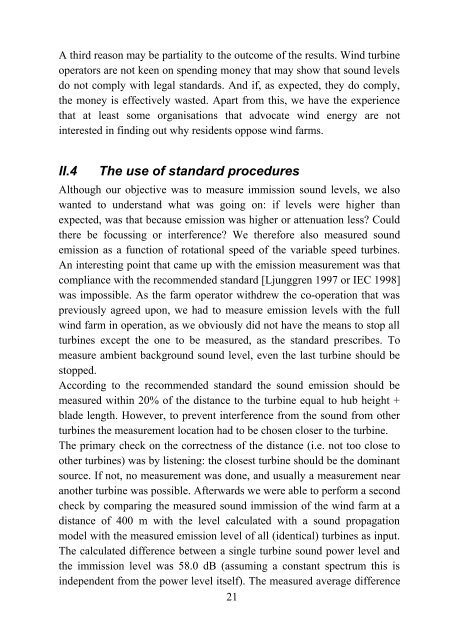The sounds of high winds
The sounds of high winds
The sounds of high winds
Create successful ePaper yourself
Turn your PDF publications into a flip-book with our unique Google optimized e-Paper software.
A third reason may be partiality to the outcome <strong>of</strong> the results. Wind turbine<br />
operators are not keen on spending money that may show that sound levels<br />
do not comply with legal standards. And if, as expected, they do comply,<br />
the money is effectively wasted. Apart from this, we have the experience<br />
that at least some organisations that advocate wind energy are not<br />
interested in finding out why residents oppose wind farms.<br />
II.4<br />
<strong>The</strong> use <strong>of</strong> standard procedures<br />
Although our objective was to measure immission sound levels, we also<br />
wanted to understand what was going on: if levels were <strong>high</strong>er than<br />
expected, was that because emission was <strong>high</strong>er or attenuation less? Could<br />
there be focussing or interference? We therefore also measured sound<br />
emission as a function <strong>of</strong> rotational speed <strong>of</strong> the variable speed turbines.<br />
An interesting point that came up with the emission measurement was that<br />
compliance with the recommended standard [Ljunggren 1997 or IEC 1998]<br />
was impossible. As the farm operator withdrew the co-operation that was<br />
previously agreed upon, we had to measure emission levels with the full<br />
wind farm in operation, as we obviously did not have the means to stop all<br />
turbines except the one to be measured, as the standard prescribes. To<br />
measure ambient background sound level, even the last turbine should be<br />
stopped.<br />
According to the recommended standard the sound emission should be<br />
measured within 20% <strong>of</strong> the distance to the turbine equal to hub height +<br />
blade length. However, to prevent interference from the sound from other<br />
turbines the measurement location had to be chosen closer to the turbine.<br />
<strong>The</strong> primary check on the correctness <strong>of</strong> the distance (i.e. not too close to<br />
other turbines) was by listening: the closest turbine should be the dominant<br />
source. If not, no measurement was done, and usually a measurement near<br />
another turbine was possible. Afterwards we were able to perform a second<br />
check by comparing the measured sound immission <strong>of</strong> the wind farm at a<br />
distance <strong>of</strong> 400 m with the level calculated with a sound propagation<br />
model with the measured emission level <strong>of</strong> all (identical) turbines as input.<br />
<strong>The</strong> calculated difference between a single turbine sound power level and<br />
the immission level was 58.0 dB (assuming a constant spectrum this is<br />
independent from the power level itself). <strong>The</strong> measured average difference<br />
21
















